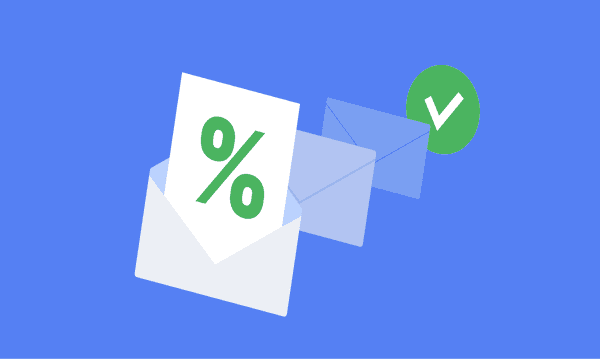How to Close More Deals with the Best Follow-up Email Templates
While the first interaction with a client captures their attention, typically, it is the follow-up that converts them from prospects to clients. In this blog post, we will help you write a solid follow-up email that generates interest and closes more deals.
7 min read

Tatiana Ogurtsovskaia
May 04, 2021

Often sales teams will focus their energy solely on capturing your prospect’s attention with the perfect first contact, every step of the customer journey is equally important and will play a key role in converting your leads into paying customers. A common mistake is to overlook the importance of a follow-up email; the follow-up email is an essential component of the sales process. When done well, it can build a relationship with your customer, keep your company at the top of their mind, and demonstrate the value of your business.
When sending sales emails, our intuition will usually tell us that if someone hasn’t responded, then they aren’t interested. However, this simply is not the case as very few deals are closed in the first ask; in fact, 80% of all sales require five follow-ups to close. So, although sending a sales follow-up email may seem daunting and slightly uncomfortable, in reality, persistence is key.
How Long Should You Wait Before Following-Up
The short answer is that there is no one answer. The right time and day to speak and send an email will depend on who you are contacting, their workload, and their schedule. The best advice is to know your customer and base your follow-up emails on what you think is appropriate; if you know that they have a demanding job, give them more time to write back, whereas if they have indicated they want to move forward, you can follow-up earlier. Although, as a rule of thumb, you can confidently follow up after about three days without making your prospect feel inundated with emails.
The average time someone needs to follow up before making a sale is five; however, the timing of each follow-up email will vary depending on what stage of the customer journey you are at. When creating the follow-up templates, you need to make sure that each email is made for each step of the customer journey and at intervals that are regular, well-thought-out, and planned.
For example:
Follow-Up After The Pitch
If you have just pitched to a client, you can follow up one to two days after the presentation; this can be an opportunity to thank them for their time, review any points that were raised in the meeting and put a call to action for the next steps.
If Your Prospect Needs To Speak To The Decision Maker
If your prospect advises that they need to speak to other stakeholders during your last interaction but do not give you a time frame to when that would be, you should look at following up around five days later; this gives them enough time to speak with their team.
Follow-Up Email After No Response
Unanswered follow-ups should follow an automated sequence; this is where you can offer additional information, discounts, or deals and simply ask them if they are still interested.
When To Send The Final Email
If all emails are going unanswered, the sequence has to come to an end. Your final email should politely wrap things up, advise them that you are closing their file, and give them one last opportunity to respond.
The good news is that technology has made following up easier than ever; with your CRM software, you can set up automated sequences that write and schedule follow-up emails in advance; this will ensure that none of your prospects fall through the cracks. Companies tend to spend a lot of time sending emails, so creating a template and automating them can help you to run a campaign at scale and save time, money, and resources.
How To Write A Follow-Up Email
In order to close deals, you need to be sending an engaging following-up with your prospects, and emails are the most convenient way to follow up with your prospects after the initial introduction or proposal. However, as people get a bunch of emails a day, how do you stop your email from falling through the cracks? Here is a list of essential components that go into creating a good follow-up email that is interesting, engaging, and closes more deals.
Start with a killer subject line that captures their attention
The subject line is the first thing that the recipient will see when they open their inbox, meaning it needs to grab their attention and make them want to open your email. Your subject line should be creative, yet straight to the point, such as: “You are missing out on…” “Today only 25% off” “Stop wasting time on meaningless work”
Personalize your pitch and provide value
Just because you are using a template doesn’t mean you cannot personalize the follow-up email. The first rule of sales is to know your customer, understand their needs and wants, so that you can tailor your pitch to be relevant to your customer. Personalization will break down barriers, help jog their memory, and help you make a lasting impression. If you have previously spoken with your prospect, you can reference something that was said in your conversation; otherwise, you could send over an article you may think will be relevant.
Time your follow-up email to be persistent but not overwhelming
We all know how we feel about spam emails; if they are too frequent, they run the risk of going straight to the bin. The key is to send effective follow-up emails that capture attention without being annoying and spamming the inbox. To do this, you need to make sure that you give them reasonable time to answer before sending an additional email; sending an email too soon can come across as pushy and imply that you are not respecting their time.
Keep it short, sweet, and professional
The most important aspect of a sales email is that it gives context; your prospect should always know why you are emailing them and what the benefit for them is. Are you offering them a free trial, is your product going to reduce their overheads or have you just featured their business in one of your blogs? While you want to provide context and value, you need to be mindful of your customer’s time, and long-winded emails are unlikely to be read, so keep your emails short and concise. Keeping it short doesn’t mean you need to do away with the pleasantries; you still need to be professional, polite, and friendly. One way to do this is to express gratitude and thank them for their time.
Include a call to action
No sales email is complete without a call to action (CTA); this is a straightforward way to encourage your prospect to act. You could ask them to arrange a meeting via a link, suggest a 30-minute follow-up call, or simply reply yes if they would like some more information. One of the biggest mistakes you can make is to leave it too vague, make your call-to-action clear and impossible to resist.
Keep following-up
Timing is everything, and while your customer may not be ready now, they may be in a few weeks, or once they have more information, the only way to know is to keep following up. Sending a follow-up email can transform the customer experience, reignite interest, strengthen relationships, and close deals.
Follow-up Email Example
Subject: Let’s work on [the problem you are solving]
Hi [Name]
It was great meeting you and learning more about what you are doing at [name of company]. As discussed, I’ve attached some more information about our solution and how we can help you solve [business issue].
Also, I checked in with my [manager], and they would be happy to provide [special discount] for you.
It would be great to jump on a quick call to clarify any questions you might have. What are your availabilities like next week?
Looking forward to hearing from you,
[Your Name]
Conclusion
Don’t underestimate the importance of a follow-up email; as a deal may just be one sales email away. While it will seem logical to assume that if someone hasn’t replied to your first email, it doesn’t always mean they are not interested. Most deals are not closed over one interaction; they take multiple follow-up emails throughout the customer journey.
Templates are great; not only do they enable you to generate interest with engaging copy, but they can help you to speed up your results at the same time. Using this guideline, you can now make your own email template that engages your prospects and persuades them to take action.


